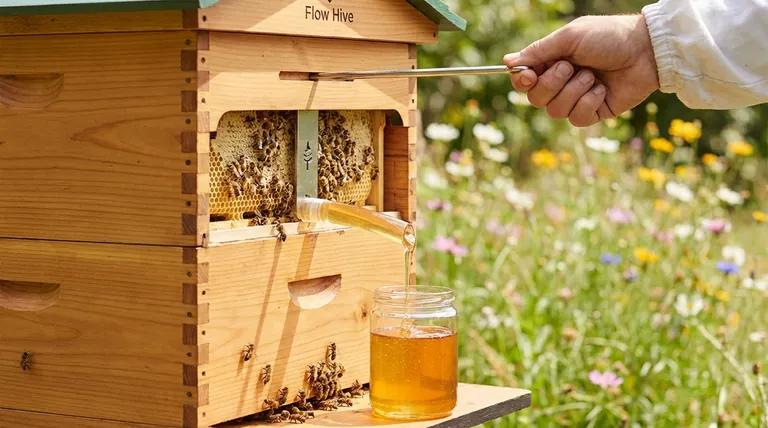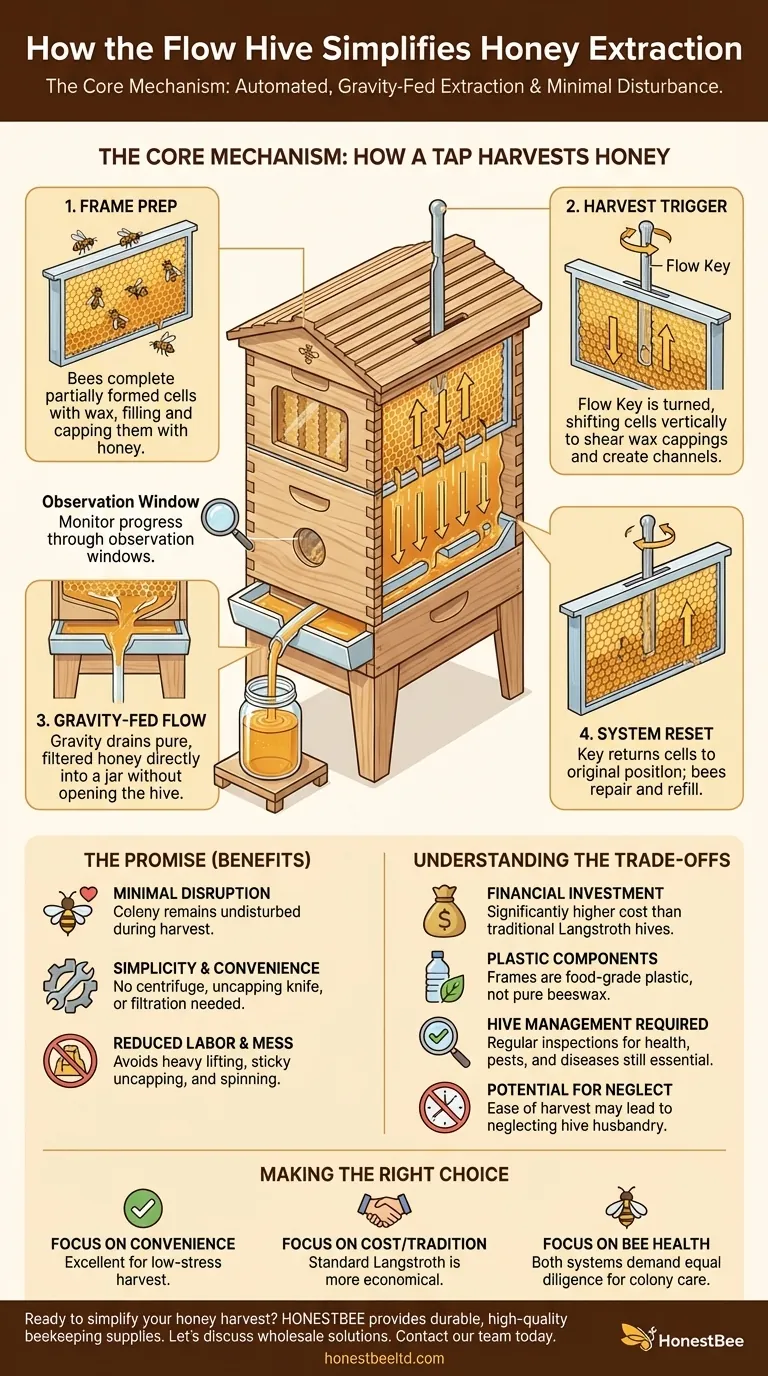At its core, a Flow Hive extracts honey by using a specialized key to mechanically split pre-formed honeycomb cells inside the hive. This action creates channels that allow pure, filtered honey to drain directly out of a tap and into a jar via gravity, all without opening the hive or significantly disturbing the bees.
The Flow Hive's design automates the single most labor-intensive part of beekeeping—honey extraction. However, this convenience introduces important trade-offs in cost, materials, and beekeeping philosophy that every potential user must understand.

The Core Mechanism: How a Tap Harvests Honey
The innovation of the Flow Hive lies entirely in its specialized honey "super" frames. These frames replace the complex, multi-step process of traditional extraction with a simple, integrated mechanical system.
The Specially Designed Flow Frames
The system uses frames made of BPA and BPS-free plastic that contain partially formed honeycomb cells. Bees complete these cells with their own wax, just as they would on a traditional foundation.
The Role of the Bees
The bees fill these plastic-and-wax cells with honey and cap them with a final wax layer when the honey is cured. Observation windows on the side of the hive allow the beekeeper to see when the frames are full and capped, signaling they are ready for harvest.
The 'Tapping' Process
The beekeeper inserts a long tool called a Flow Key into a slot at the top of the frame and turns it 90 degrees. This movement shifts the cells vertically, creating a shearing action.
This offset motion breaks the wax cappings on both sides of the comb simultaneously, turning the sealed cells into open channels.
The Gravity-Fed Flow
Once the channels are open, gravity takes over. The honey flows down through these channels into a sealed trough at the bottom of the frame and then out of the hive through a tube, directly into a collection jar. The process is clean and contained.
Resetting the System
After the honey has drained, the beekeeper turns the Flow Key back to its original position. This realigns the cells, which are now empty. The bees will then repair the wax cappings and begin refilling the cells with honey.
The Promise: Why Beekeepers Choose Flow Hives
The primary appeal of the Flow Hive is its radical simplification of the honey harvest. It aims to make beekeeping more accessible and less stressful for both the beekeeper and the bees.
Minimal Disruption to the Colony
Traditional harvesting requires opening the hive, smoking the bees, removing heavy frames, and transporting them to a separate location. The Flow Hive eliminates these steps, leaving the bee colony almost entirely undisturbed during the harvest itself.
Simplicity and Convenience
There is no need for expensive and cumbersome extraction equipment like a centrifuge, an uncapping knife, or filtration systems. The harvest is reduced to the simple act of turning a key.
Reduced Labor and Mess
Harvesting with a Flow Hive avoids the heavy lifting of honey-laden boxes and the sticky, messy process of uncapping and spinning frames.
Understanding the Trade-offs and Criticisms
While the benefits are significant, an objective assessment requires understanding the associated trade-offs. The convenience of the Flow Hive comes with considerations that may not suit every beekeeper.
The Financial Investment
Flow Hives are significantly more expensive than traditional Langstroth hives. The cost of the patented frame technology is the primary driver of this price difference.
The Use of Plastic Components
The honey-storing frames are made of plastic. While they are food-grade, some beekeepers have a strong preference for keeping their hives entirely free of plastic, favoring natural materials like wood and pure beeswax foundation.
Hive Management Is Still Required
The ease of harvesting can create a dangerous misconception that the hive is a "set it and forget it" system. This is not true. Beekeepers must still perform regular inspections of the brood box to monitor for pests (like varroa mites), diseases, and the overall health of the queen and colony. These inspections are just as invasive as in a traditional hive.
Potential for Neglect
The very simplicity of the harvest might lead a novice beekeeper to focus only on honey production, potentially neglecting the critical hive husbandry required to maintain a healthy, thriving colony.
Making the Right Choice for Your Goal
The Flow Hive is an excellent tool, but it is not the universally "best" solution for every situation. Your personal goals in beekeeping should guide your decision.
- If your primary focus is convenience and a low-stress harvest: The Flow Hive is an outstanding choice that eliminates the most physically demanding and disruptive part of the process.
- If your primary focus is minimizing cost or practicing traditional methods: A standard Langstroth hive is far more economical and aligns with time-honored beekeeping practices.
- If your primary focus is bee health above all: Both systems demand equal diligence. The Flow Hive's key benefit is isolated to the harvest; day-to-day colony care and health management remain identical and essential.
Ultimately, choosing the right hive is about matching the equipment to your personal beekeeping philosophy and goals.
Summary Table:
| Process Step | Key Action | Result |
|---|---|---|
| Frame Preparation | Bees complete plastic cells with wax. | Honeycomb is ready for filling. |
| Harvest Trigger | Turn the Flow Key 90 degrees. | Wax cappings shear, creating channels. |
| Honey Extraction | Gravity drains honey through channels. | Pure honey flows directly into a jar. |
| System Reset | Turn the Flow Key back. | Cells realign for bees to clean and refill. |
Ready to simplify your honey harvest? Whether you manage a commercial apiary or supply equipment to distributors, HONESTBEE provides the durable, high-quality beekeeping supplies you need to succeed. Let's discuss how our wholesale-focused solutions can support your operation. Contact our team today for expert advice and pricing.
Visual Guide

Related Products
- HONESTBEE 72 Frame Industrial Electric Honey Extractor for Beekeeping
- 8-Frame Electric Self-Reversing Honey Extractor Spinner for Commercial Honey Extraction Equipment
- 40 Frame Commercial Electric Honey Extractor for Beekeeping
- Commercial Electric 12 Frame Honey Extractor Spinner Motorized Honey Extractor
- HONESTBEE 6 Frame Three Use Electric Honey Extractor for Beekeeping
People Also Ask
- What are the two common types of honey extractors? Choose the Right Extractor for Your Apiary
- How do automatic honey extractors function? Achieve High-Efficiency Honey Harvesting
- How is honey harvested from Langstroth hives? A Guide to Efficient, Comb-Preserving Extraction
- What are the advantages of automated honey extractors in terms of time efficiency? Boost Your Harvest Speed
- What should a beekeeper do after extracting honey from supers? A Guide to Harvest Management



















